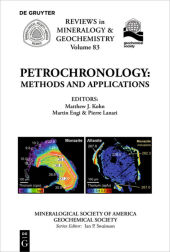 Neuerscheinungen 2017Stand: 2020-02-01 |
Schnellsuche
ISBN/Stichwort/Autor
|
Herderstraße 10
10625 Berlin
Tel.: 030 315 714 16
Fax 030 315 714 14
info@buchspektrum.de |

Petrochronology
Methods and Applications
2017. XIV, 582 S. 230 mm
Verlag/Jahr: DE GRUYTER 2017
ISBN: 0-939950-05-7 (0939950057)
Neue ISBN: 978-0-939950-05-8 (9780939950058)
Preis und Lieferzeit: Bitte klicken
Reviews in Mineralogy & Geochemistry (RiMG) volumes contain concise advances in theoretical and/or applied mineralogy, crystallography, petrology, and geochemistry.
Petrochronology is a rapidly emerging branch of Earth science that links time (ages or rates) with specific rock-forming processes and their physical conditions. It is founded in petrology and geochemistry, which define a petrogenetic context or delimit a specific process, to which chronometric data are then linked. This combination informs Earth´s petrogenetic processes better than petrology or geochronology alone. This volume and the accompanying short courses address three broad categories of inquiry. Conceptual approaches chapters include petrologic modeling of multi-component chemical and mineralogic systems, and development of methods that include diffusive alteration of mineral chemistry. Methods chapters address four main analytical techniques, specifically EPMA, LA-ICP-MS, SIMS and TIMS. Mineral-specific chapters explore applications to a wide range of minerals, including zircon (metamorphic, igneous, and detrital/Hadean), baddeleyite, REE minerals (monazite, allanite, xenotime and apatite), titanite, rutile, garnet, and major igneous minerals (olivine, plagioclase and pyroxenes). These applications mainly focus on metamorphic, igneous, or tectonic processes, but additionally elucidate fundamental transdisciplinary progress in addressing mechanisms of crystal growth, the chemical consequences of mineral growth kinetics, and how chemical transport and deformation affect chemically complex mineral composites. Most chapters further recommend areas of future research.
Matthew J. Kohn, Martin Engi, Pierre Lanari.


